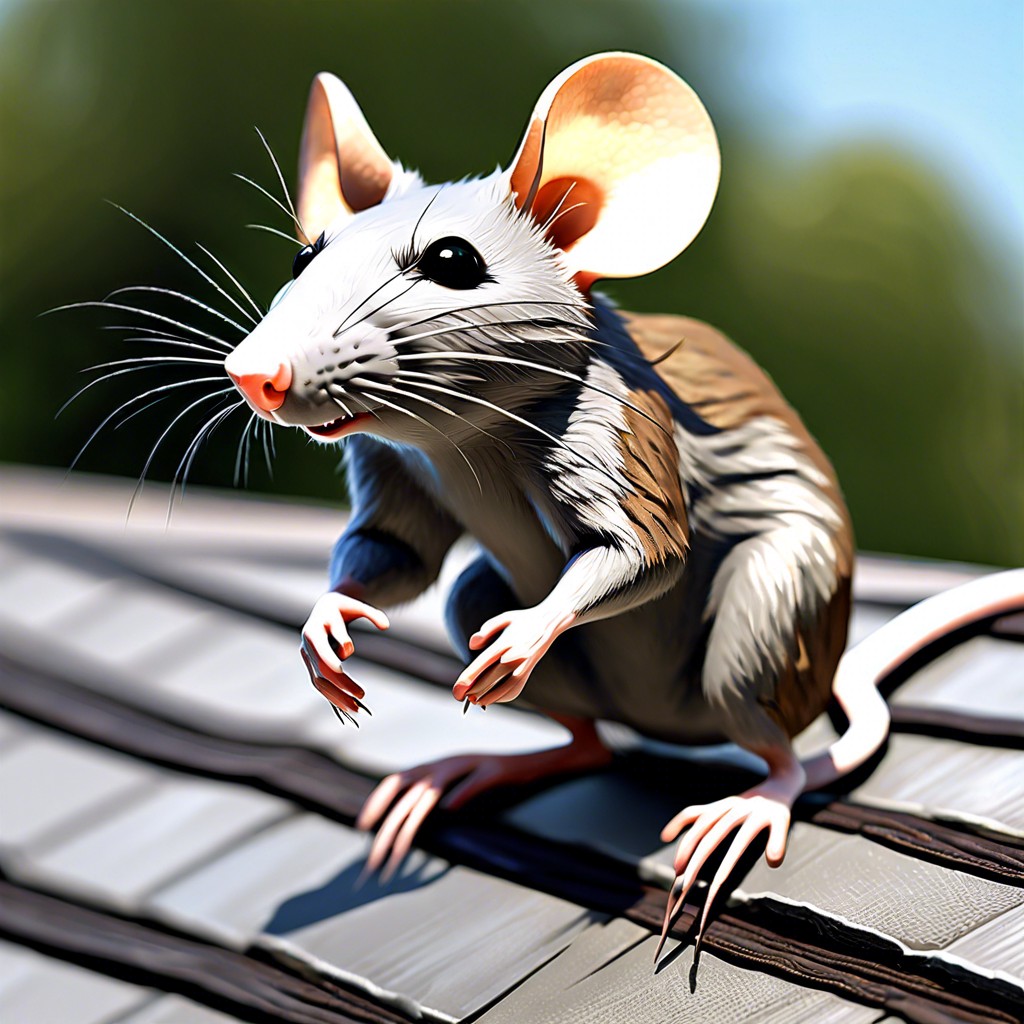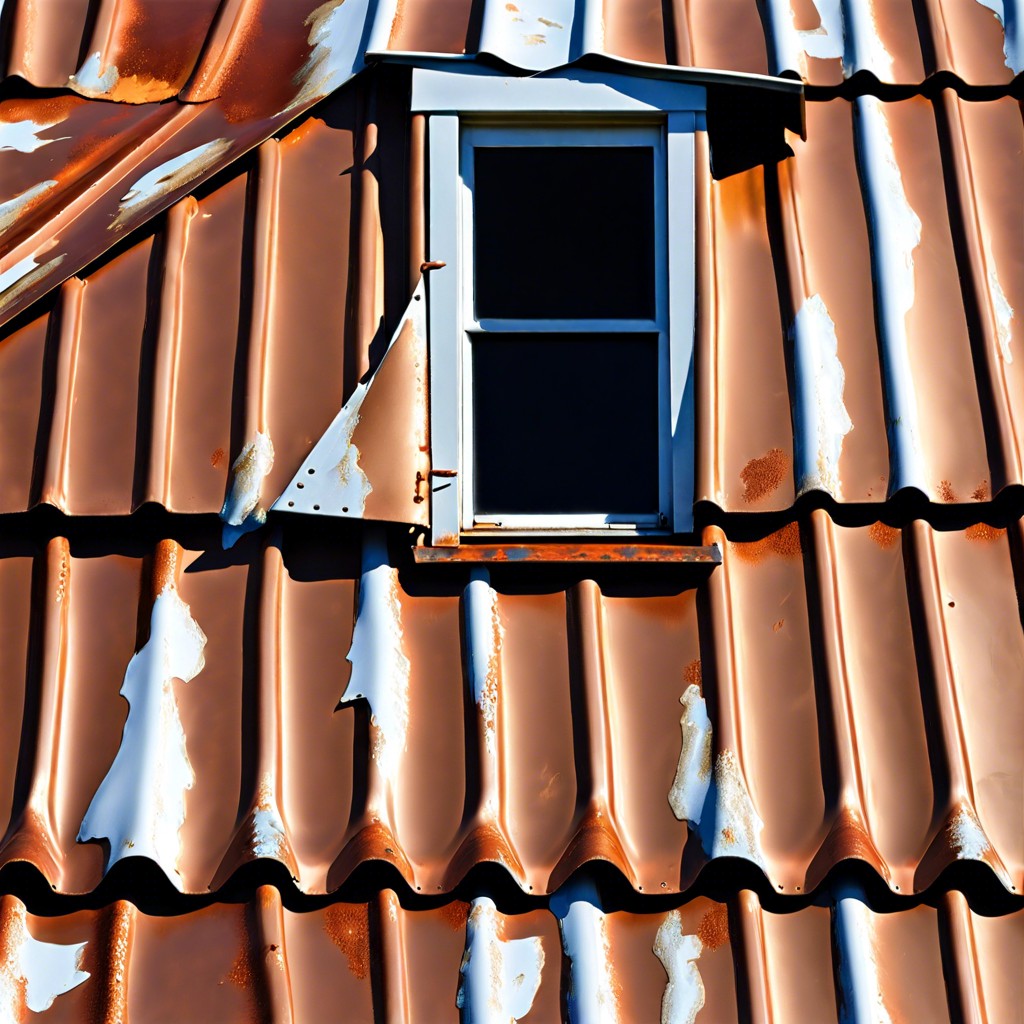Last updated on
Discover effective ways to detect and control roof rats and protect your home from these unwelcome guests.
Key takeaways:
- Roof rats have sleek bodies and are adept climbers.
- They prefer nesting in high areas like attics and roofs.
- Roof rats have a varied diet and follow the same paths every night.
- Signs of roof rat infestation include gnawed wires and insulation, musty odors, and droppings.
- Prevention methods include sealing entry points, keeping the garden trimmed, and maintaining a clean and clutter-free attic.
Roof Rats Identification

Distinct from their ground-dwelling cousins, these rodents have a knack for acrobatics. With sleek, agile bodies, they’re primed for scaling vertical surfaces. A typical adult has a body length of about 6 to 8 inches and a tail that surprisingly exceeds its body length. With smooth, black or dark brown fur, these creatures could easily be mistaken for a shadow scampering across your fence.
Their pointed muzzles, large eyes, and ears lend them a sharp appearance – they’re the spies of the rodent world, alert and ready for action. If you happen upon droppings shaped like spindles, typically about half an inch, consider it a calling card of these nocturnal intruders.
They’re drawn to the high life, preferring the upper stories of buildings to establish their nest. You’ll find them seeking sanctuaries in attics, rafters, or roofs, away from ground-level threats and closer to their preferred dining, which includes fruits, seeds, and nuts.
Behavior, Diet & Habits
These nimble critters are the acrobats of the rodent world — think of them as the trapeze artists in your attic. They have a penchant for the high life, preferring to nest above ground in shrubs, trees, or dense vegetation but won’t shy away from making a cozy abode in the upper parts of structures.
When they’re not busy perfecting their high-wire act, roof rats are known for their varied palate. They’re omnivorous, meaning they’ll nibble on a smorgasbord that includes fruits, nuts, seeds, and plant materials, though they wouldn’t say no to a meat or grain dish either. Their diet changes with the availability of food, which makes them particularly adaptable.
These rats are also creatures of habit. They follow the same paths along fences, utility lines, and tree branches each night. Look out for their dark, greasy rub marks left behind as evidence of their predictable travel routes.
Despite their outdoorsy habits, when the weather takes a turn, these rats may invite themselves into your home, and not just as temporary guests. They’re searching for a trifecta of essentials: food, water, and shelter. And once they find them, they can become quite the unwelcome housemates, setting up shop in your insulation or between walls.
Roof rats are also expert breeders. One pair can be the founding family for a full-blown infestation in no time — with females producing up to four litters a year and each litter housing half a dozen or more pups.
Understanding their behavior, diet, and habits puts you in a better position to tackle any roof rat issues head-on, with speed and precision. Keep an eye out for tell-tale signs and you’ll be prepared to defend your home from these uninvited gymnasts of the night.
Signs of an Infestation of Roof Rats
Spotting the subtle hints of uninvited guests in your attic can be the key to preventing a full-blown roof rat invasion. These critters leave behind a breadcrumb trail of clues; you just need to know what to look for.
Take a peek at your electrical wires or attic insulation—if they look like they’ve been in a tussle with a set of tiny teeth, roof rats may be the culprits. These rodents have a knack for gnawing, and damaged materials in these areas often raise a red flag.
Next up, keep your nose on alert for a musty odor that seems out of place. It’s not your imagination—that distinct scent could be a calling card from these stealthy squatters. And if you’re hearing scurrying or scratching noises overhead as the sun dips below the horizon, that’s not the house settling; it’s more likely the pitter-patter of tiny rat feet.
But the proof is often in the pudding, or in this case, their droppings. Tiny, spindle-shaped pellets littered around your home can be a telling sign. They’re usually found where food is stored, under sinks, along baseboards, or in dark, secluded corners.
Lastly, don’t overlook the outdoor signs: fruit and nuts nibbled on, burrows beneath the compost pile or garden, or greasy rub marks along your walls where their fur leaves a trace. If any of these signs appear familiar, it might be time to roll up your sleeves and take action against these uninvited attic aficionados.
Getting Rid of Roof Rats
Dealing with these uninvited attic guests can test your patience, but don’t throw in the towel just yet. Start with exclusion tactics by sealing entry points. Check for gaps where utility lines enter and alongside roof joints—rats only need a hole the size of a quarter to squeeze through.
Next, consider traps. Snap traps are a classic, but use them wisely. Place them in high-traffic areas, typically along the edges since rats tend to follow the same paths. And remember, peanut butter is to roof rats what cheese is to cartoons mice—a surefire bait.
Chemical baits and poisons are options too, but they carry risks, especially with pets or children around. If going this route, ensure that you understand the correct placement and use; read the instructions like you’re studying for a pop quiz.
Consulting a professional could save you a headache larger than a rat’s nest. Pest control experts are the secret weapon in your battle against these agile adversaries. They’re the maestros of mouse (and rat) traps, understanding the critter’s habits better than they know themselves.
Remember, patience is key. Feel like you’re playing a game of whack-a-mole without the mallet sometimes? Normal. Rats are wily; it often takes several attempts to show them the door for good. Keep at it, and victory will be yours (and your home’s).
How to Prevent a Roof Rat Infestation
Sealing entry points is a critical step. Rats can squeeze through spaces as small as a quarter. Check your roof for any gaps and seal them with wire mesh or caulk.
Keep your garden in check; overgrown vegetation offers rats a VIP pass straight to your roofline. Trim back trees and shrubs away from the house to discourage aerial acrobatics from these nimble pests.
Don’t roll out the welcome mat with food. Keep garbage in secure bins and dispose of waste regularly. Pet food bowls should be emptied after Fido finishes his meal.
Attics and crawl spaces should be free of clutter. These spaces can become luxury hotels for rats if not kept neat and tidy.
Water sources are like a rooftop rat spa. Fix leaks promptly and make sure gutters are clean to prevent water pooling.
Considering a cat as your next housemate? Their presence alone can deter rats. Just the scent of a predator can send rodents scurrying elsewhere.
Regular roof checks can save you a headache down the line. A yearly inspection by a professional can catch signs of a rodent rendezvous before it turns into an infestation.





